![]()
![]()
![]()
Use LEFT and RIGHT arrow keys to navigate between flashcards;
Use UP and DOWN arrow keys to flip the card;
H to show hint;
A reads text to speech;
17 Cards in this Set
- Front
- Back

David by Donatello
Bronze Early Italian Renaissance |
Earliest known free standing bronze nude since antiquity
David= symbol of Florence effeminate: homoerotic possibly girly to highlight the heroism of the young child |
|
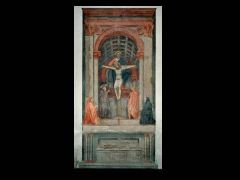
Trinity with the Virgin, St John the Evangelist and Donors by Masaccio
Fresco Early Italian Renaissance |
Use of linear perspective
horizon line below kneeling figures dove= holy spirit figures closest to Christ= John and Mary other figures= members of Lenzi family who commissioned it |
|
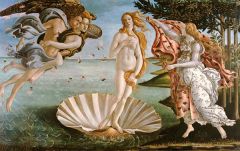
The Birth of Venus by Botticelli
tempera and gold on canvas Early Italian Renaissance |
Modest Venus from classical Greek art
birth of Venus= advent of beauty original purpose may have been a banner/wall hanging use of horizon line |
|
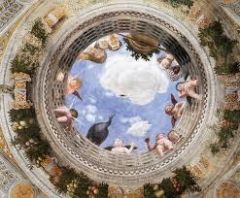
False Oculus by Mantegna
Fresco Early Italian Renaissance |
perspective
foreshortening (method of rendering a specific object or figure in a picture in depth) illusionistic |
|
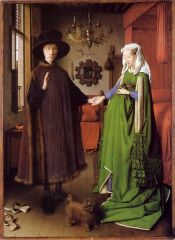
Arnolfini Double Portrait by Jan van Eyck
Oil on wood Early Renaissance Northern Europe |
Example of new wealth of middle class
man has distinct face; woman more general possible funeral portrait: wife maybe died in childbirth prayer beads and mirror= piety |
|
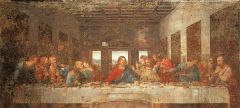
The last supper by Leonardo da Vinci
tempera and oil on plaster Italian High Renaissance |
wall painting on monastery wall
tempera= paint w/ egg; works on wood not plaster started peeling almost immediately Jesus middle via orthogonal lines; use of linear perspective horizon line looks like halo Da Vinci obsessed w/ facial expression & features 1 of 1st studies of human reaction & emotion |
|
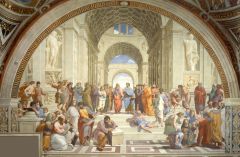
The School of Athens by Raphael
Fresco Italian High Renaissance |
wall painting on Pope Julius II library wall
showcases Greek intellectuals Plato in middle; pointing up= spirituality Aristotle in middle; pointing down= physical some subjects resemble Rap. fam and role models Michelangelo shown as cynic philosopher Diogenes; indicative of his character ironic this pagan painting in Pope's library |
|
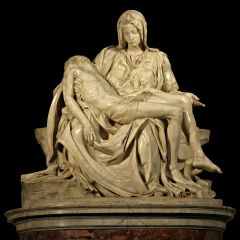
Pieta by Michelangelo
Marble Italian High Renaissance |
commissioned by a French Cardinal
represents Mary's pity for her son marble block selected from marble quarry in Carrara Michel very particular about his marble felt he was setting the sculpture free from the marble anatomy= very realistic few times mich signed his name (in band across mary's chest) |
|
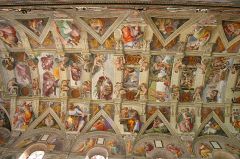
Sistine chapel ceiling by Michelangelo
fresco Italian High Renaissance |
Ceiling painting
took 4 years to complete Mich. was angry with Pope Julius for pulling him from previous project to work on Sistine Chapel considered himself a sculptor before a painter false architecture is painted into the ceiling ignudi= random guys in various poses |
|
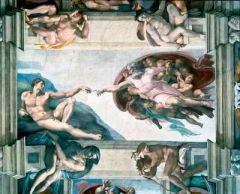
Creation of Adam by Michelangelo from Sistine Chapel ceiling
fresco Italian High Renaissance |
Ceiling painting
no angels have wings Michel had no patience for frills such as wings, halos, etc Adam mimics god's pose acorns are all over ceiling of Sistine Chapel (symbol of Pope Junius' family |
|
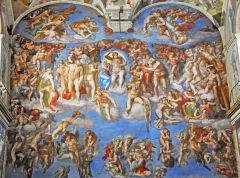
The Last Judgement by Michelangelo
fresco Italian High Renaissance |
Wall painting in Sistine Chapel
bad time in Rome's history Rome sacked by Germans in 1527 Christ in center with Mary cowering next to him Lots of emphasis on the physical suffering of saints and martyrs no wings on demons or angels Most of the figures are nude |
|
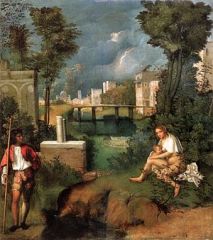
The Tempest by Giorgione
Oil on canvas Italian High Renaissance (Venice) |
features a mysterious subject
no one knows who the subjects are lots of landscape (rivers, storm, trees) possibly pastoral theme skillful depiction of storms and atmosphere |
|
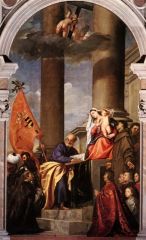
Pesaro Madonna by Titian
oil on canvas Italian High Renaissance (Venice) |
featured in pesaro chapel
commissioned by Pesaro family who were very powerful and helped to defeat the Turks One member of the family is seen dragging a Turk Vibrant colors used |
|
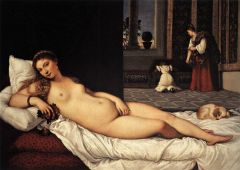
Venus of Urbino by Titian
oil on canvas Italian High Renaissance |
found in Duke of Urbino's house
one of first "pin up women" famous for the inviting look she gives to the audience Titian is famous for his use of naked women Venetians were famous for prostitutes who were talented (played instruments, wrote poetry etc) |
|
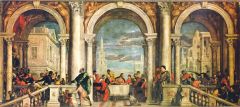
Feast in the House of Levi by Veronese
Oil on canvas Italian High Renaissance (Venice) |
in dining room of monastery
monasteries used to be luxurious (seems ironic given that monks are supposed to live minimally and devote their lives to their religion) originally was called last supper but Veronese was forced to change the name by the Inquisition famous Venetian noble men are depicted |
|

The Last Supper by Tintoretto
Oil on Canvas Italian High Renaissance (Venice) |
Tintoretto was known for his spiritual scenes
Christ has very bright halo around his head all the disciples have a slight glow less organized than Da Vinci's Last Supper angels look like ghosts emotionally intense good example of counter reformation shows poverty and the poor |
|
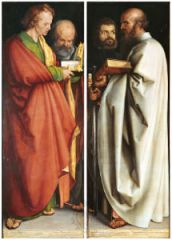
Four Apostles by Durer
Oil on wood panel German High Renaissance |
impressed by Bellini
early supporter of Martin Luther protestant painting left panel= St. John the evangalist (guy with book which represents his sanguine disposition) and St peter (key= key to church as first pope) Right panel= St Mark (guy in back, mean look matches personality), St Paul (weird look and sword represent him being melancholy) |

